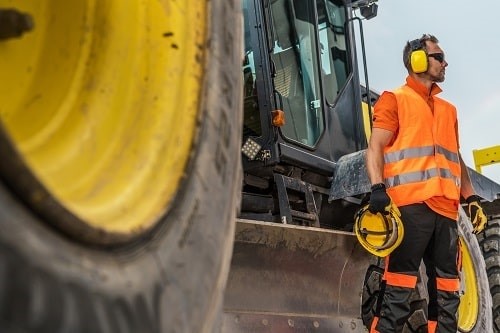Construction sites can be dangerous places, especially for those without health and safety training.
Features
The top five construction site risks and hazards
It’s estimated that one in 10 construction workers are injured on site every year, and it’s for this reason we need to recall some of their common risks and hazards.
- Falls from height
Falls from height are the biggest cause of fatal injuries at work. The Health and Safety Executive (HSE) statistics show that 40 workers were killed as a result of a fall from height in 2018/19. Since work at height is carried out every day within the construction industry, this is a daily risk that workers must be prepared for.
Examples of work at height include:
- working on a roof
- using vertical ladders
- working on a wind turbine
- working on below-level walkways.
The Working at Height Regulations 2005 state that work at height should be avoided, if possible. If it cannot be avoided, then it is the responsibility of the site manager to ensure all work is planned, organised, risk assessed, controlled, supervised and carried out with a safe system of work. Equipment should also be checked to ensure it is competent, and employees should have the required training and knowledge to undertake the work safely.
On a construction site, work at height can take place in many different forms, all of which carry their own risks. For example, when working on a roof, it is important the rigidity of the roofing material is considered. If deemed fragile, specific controls will need to be put in place to prevent accidents.
- Slips, trips and falls
In 2018/19, slips, trips and falls on the same level accounted for 29 per cent of non-fatal injuries within the construction industry. This just shows that slips, trips and falls are the single biggest cause of non-fatal injury. Making small changes can vastly reduce the number of injuries incurred on site.
Causes of slips, trips and falls are:
- wet and slippery surfaces
- slick spots
- clutter and strewn materials
- uneven surfaces
- obstruent debris.
To combat this, workers are required to wear suitable footwear with maximal grip. Also, any wet or slippery surfaces should be well signposted with a slippery floor warning sign. The construction site must be clutter-free and with equipment, tools and building materials in good order. If working areas are not kept tidy, there is more of a chance of someone being injured by tripping over.
 Around 21,000 construction workers in the UK suffer from work-related hearing problems
Around 21,000 construction workers in the UK suffer from work-related hearing problems
- Hearing problems
Not only in the construction industry but also in everyday life, overexposure to loud noises can lead to hearing problems. However, this is a major risk within the construction working environment, with an estimated 21,000 construction workers in the UK suffering from work-related hearing problems and 55 claims of work-related deafness in 2018.
Sources of hearing problems are:
- power tools and groundwork equipment
- loud machinery
- supply vehicles.
When working with loud equipment, employees are required to wear hearing protection. This consists of a set of soundproof headphones, which will reduce the intensity of sound waves entering the ears and therefore reduce the risk of developing hearing problems.
- Back injuries
Moving heavy objects without adequate training can cause severe back injuries, which can lead to permanent damage. When moving objects, it is important to bend the legs and lift heavy items using the leg muscles rather than bending the back. Lifting incorrectly is the way most back injuries are incurred. It is a legal requirement for employees to ensure manual handling health and safety training is available to all employees
who are required to do any heavy lifting.
- Falling objects
With most construction work involving multistorey buildings, there is a degree of risk that someone working above may drop a tool or object resulting in someone below being hit. Workers are required to carry tools on a lanyard to reduce the risk of dropping things on people working or walking below.
More information here: hse.gov.uk
Kati de Matas is Content and marketing assistant at MRS Training & Rescue
FEATURES

Sedentary working and how to combat the ‘sitting disease’
By Gavin Bradley, Active Working on 05 April 2024
Prolonged and excessive sitting poses a major risk to our health, but the Get Britain Standing campaign and On Your Feet Britain Day on 25 April are a great way of encouraging workers to sit less and move more.

Company culture and wellbeing: a crucial link
By Bex Moorhouse, Invigorate Spaces on 05 April 2024
Investing in measures to support worker wellbeing will be ineffective unless the company culture genuinely incorporates values like teamwork, involvement, flexibility and innovation.

Office design and culture: happier and healthier staff – or the opposite?
By Guy Osmond, Osmond Ergonomics on 03 April 2024
Applying ergonomic principles to workstation set-ups and ensuring the physical environment supports neurodivergent people are just some of the ways of creating an office where everyone can thrive, but a supportive and positive organisational culture is vital too.


